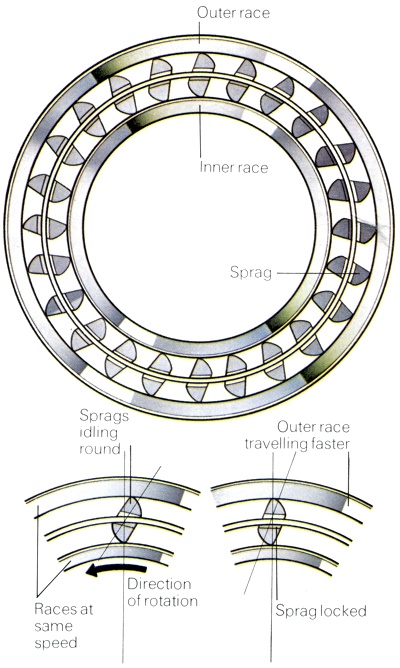
The Ferguson system overcame the limitations of a conventional differential by the use of one way sprag clutches to lock the unit should wheelspin occur. While the inner and outer races were revolving at the same speed, the sprags would "idle" round with them, if one race started to revolve faster, the sprags would lock. |
Introduction
A 4WD system often overlooked these days was the Ferguson design, which was fitted to the
Jensen FF and first put into production in
1964. The system represented a great advance in 4WD design because it incorporated sensors which controlled clutches that adjusted the available torque between the front and rear of the car in the event of wheel-spin developing at any of the wheels. Unless all four wheels lost their grip simultaneously such as when hitting black ice, wheel-spin was completely eliminated - a major advance in road safety.
The Ferguson System
While few people doubt the advantages of 4WD in providing extra traction for utility vehicles, there have been far fewer attempts to drive all four wheels of an ordinary road-going car which has no cross-country pretensions. In fact, as long as drive can be maintained to all four wheels and the layout of the components was properly balanced in the first place, there was every reason to expect a AWD road car to handle extremely well. The major problem was that a plain centre differential arrangement was unsatisfactory because it will allow wheelspin, developed at one end of the car, to upset its whole handling behaviour.
The Ferguson system, first seen on the F1 Grand Prix car in
1961, overcame this problem and was the only such system to have been sold on a high-performance car, the Jensen FF. The system overcomes the limitations of the differential by using two one-way sprag clutches, each bridging the two sides of the differential but acting in opposite directions. The gears connecting the clutches with the differential are chosen so that as long as all of the wheels are being driven normally the two clutches idle round in their "free" direction. If, however, a wheel does lose its grip and starts to spin, the action of the differential locks the appropriate clutch, limiting the amount of spin and transmitting the excess torque to the other end of the car.
The system allowed the shafts driving the front and the rear wheels to revolve at different speeds (an essential factor because the front and rear wheels take a different line round a corner) but it prevents this difference from exceeding a pre-determined percentage of the average speed. This percentage was determined by the diameters of the sun and planet gears and these gears will therefore have to be changed if a different percentage figure was required for some reason.
A second advantage of this arrangement was that the control system also works during braking so that if any wheel locks, the braking torque through the drive-shafts was transferred to the opposite end of the car. When the Jensen FF was introduced this was considered a major advance in road safety and in recognition of this the car was awarded the Don Safety Award in
1965. From the driver's point of view, the Ferguson system meant that wheelspin was eliminated, unless all four wheels lost their grip simultaneously, and that the chances of the wheels locking under braking were greatly reduced. As applied to the
Jensen FF the system proved itself beyond all doubt but its expense and complication weighed against its more widespread adoption.



